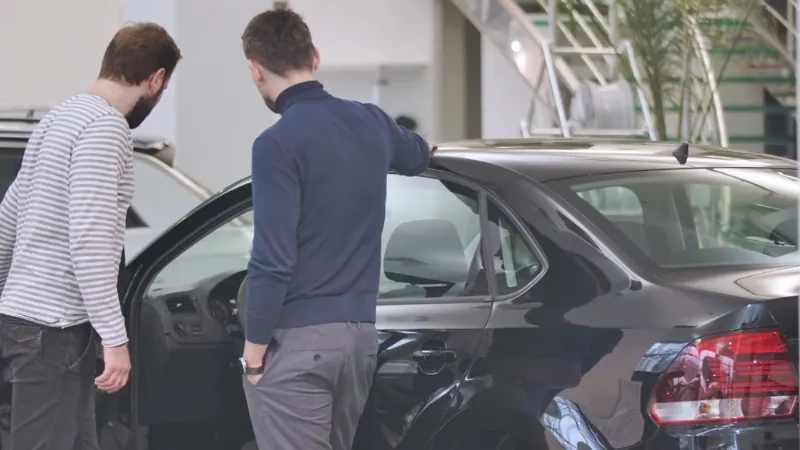
Share Post:
If you’ve ever dreamed of cruising through city streets in something that looks like it’s straight out of a sci-fi movie, you’re not alone.
Designers and engineers have been pushing the boundaries of automotive aesthetics for decades, resulting in vehicles that feel more at home on a distant planet than on a highway.
Here’s a look at 20 extraordinary cars that resemble spaceships, combining futuristic designs with cutting-edge technology.
Table of Contents
Toggle20. Kia EV6

The EV6’s exterior is a head-turner, featuring a low-slung silhouette and aggressive front fascia that exude a futuristic vibe.
But it’s not all about looks; the EV6 delivers impressive performance across its range:
- EV6 Air: Equipped with a 77.4 kWh battery, this rear-wheel-drive model offers 226 bhp, accelerating from 0 to 60 mph in 7.3 seconds.
- EV6 GT-Line: Available in both rear-wheel and all-wheel-drive configurations, the GT-Line provides up to 321 bhp, achieving 0 to 60 mph in as little as 5.2 seconds.
- EV6 GT: The pinnacle of the lineup, the GT boasts a staggering 577 bhp, propelling it from 0 to 60 mph in just 3.4 seconds.
Advanced Battery and Charging Capabilities
One of the standout features of the EV6 is its rapid charging capability. Thanks to its 800-volt architecture, the EV6 can charge from 10% to 80% in approximately 18 minutes when connected to a 240kW charger. Its driving range is close to driving range of Kia EV9.
This means less time tethered to a charging station and more time enjoying the open road.
Spacious and Tech-Forward Interior
Inside, the EV6 offers a roomy cabin with cutting-edge technology. The dual 12.3-inch curved displays provide clear visuals for both the instrument cluster and infotainment system.
Premium materials and ambient lighting create an inviting atmosphere, making every journey comfortable.
Key Specifications
| Specification | EV6 Air | EV6 GT-Line | EV6 GT |
| Battery Capacity | 77.4 kWh | 77.4 kWh | 77.4 kWh |
| Power Output | 226 bhp | Up to 321 bhp | 577 bhp |
| 0-60 mph | 7.3 seconds | As quick as 5.2s | 3.4 seconds |
| Top Speed | 114 mph | Up to 116 mph | 162 mph |
| Range (WLTP) | Up to 328 miles | Up to 339 miles | 263 miles |
19. Rimac Nevera

Embracing the philosophy of form following function, the Nevera’s design is both purposeful and captivating. Its sleek lines and aerodynamic profile are not just for show; they enhance performance and efficiency.
The signature ‘necktie’ design, inspired by Croatian heritage, is sculpted into its flanks, serving as both a visual cue and a functional aerodynamic feature.
Performance and Specifications
Beneath its striking exterior lies a powerhouse of electric engineering. The Nevera is equipped with four liquid-cooled permanent magnet synchronous electric motors, one at each wheel, delivering a combined output of 1,914 horsepower and 2,360 Nm of torque.
This immense power enables the Nevera to accelerate from 0 to 100 km/h in just 1.81 seconds and reach a top speed of 412 km/h (258 mph).
Key Specifications
| Specification | Details |
| Power Output | 1,914 hp |
| Torque | 2,360 Nm |
| 0-100 km/h | 1.81 seconds |
| Top Speed | 412 km/h (258 mph) |
| Battery Capacity | 120 kWh |
| Range | 490 km (WLTP) |
| Charging Time | 0-80% in less than 30 minutes |
Advanced Technology
The Nevera is packed with innovative features that enhance both performance and safety. Its AI Driver Coach utilizes 12 ultrasonic sensors, 13 cameras, and six radars to provide real-time guidance, helping drivers optimize their driving lines and braking points on the track.
Additionally, the car supports over-the-air updates, ensuring that its systems remain up-to-date with the latest advancements.
Exclusivity and Personalization
Rimac plans to produce only 150 units of the Nevera, making it a highly exclusive vehicle. Each car can be customized to reflect the owner’s personal taste, ensuring that no two Neveras are exactly alike.
This level of personalization extends to both the exterior and interior, allowing for a truly unique driving experience.
18. Lotus Evija

The Evija’s exterior is a testament to Lotus’s “Carved by Air” philosophy, with fluid lines and sculpted surfaces that enhance both aesthetics and aerodynamics.
Notable features include the dramatic Venturi tunnels that pierce through the rear quarters, optimizing airflow and creating a striking visual effect. The absence of traditional door mirrors, replaced by discreet cameras, further reduces drag and adds to its futuristic appeal.
Performance and Specifications
Beneath its captivating exterior, the Lotus Evija houses a formidable all-electric powertrain. Equipped with four electric motors, one at each wheel, it delivers a combined output of 1,973 horsepower and 1,256 lb-ft of torque.
This immense power enables the Evija to accelerate from 0 to 100 km/h (0 to 62 mph) in just under three seconds, with a top speed exceeding 320 km/h (200 mph).
Key Specifications
| Specification | Details |
| Power Output | 1,973 hp |
| Torque | 1,256 lb-ft |
| 0-100 km/h | Under 3 seconds |
| Top Speed | Over 320 km/h (200 mph) |
| Battery Capacity | 93 kWh |
| Range | Approximately 346 km (WLTP) |
| Charging Time | 0-80% in less than 20 minutes |
Advanced Technology
The Evija is not just about raw power; it’s a showcase of advanced technology. Its carbon fiber monocoque chassis ensures a lightweight yet rigid structure, enhancing performance and handling.
The interior features fully adjustable race-style seats and a multi-function steering wheel, emphasizing its motorsport-inspired design. Additionally, the car offers multiple driving modes—Range, City, Tour, Sport, and Track—allowing drivers to tailor the driving experience to their preferences.
Exclusivity and Personalization
Lotus plans to produce only 130 units of the Evija, making it an exceptionally exclusive vehicle. Each car can be customized to reflect the owner’s personal taste, ensuring a unique expression of individuality.
This level of personalization extends to both the exterior and interior, allowing for a truly bespoke driving experience.
17. HiPhi Z
The HiPhi Z’s exterior is a bold statement, featuring sharp angles, dynamic lines, and a distinctive lighting system. Its “Star Ring” Intelligent Signal Display (ISD) incorporates over 4,000 LEDs, allowing for customizable light patterns that interact with the environment.
This innovative feature not only enhances its visual appeal but also serves functional purposes, such as signaling and communication with other road users.
The vehicle’s NT door design offers a unique approach to ingress and egress, providing ample space and a futuristic feel. Additionally, the 22-inch wheels come equipped with soft rubber inserts, protecting the hubs from scratches while maintaining a visually stunning appearance.
Key Specifications
| Specification | Details |
| Power Output | 662 bhp (671 PS / 494 kW) |
| Torque | 820 Nm (605 lb-ft) |
| 0-100 km/h | 3.8 seconds |
| Top Speed | 200 km/h (124 mph) |
| Battery Capacity | 120 kWh |
| Range | Approximately 555 km (WLTP) |
| Charging Time | 0-80% in less than 20 minutes |
Advanced Technology
The HiPhi Z is equipped with cutting-edge technology that enhances both driver experience and safety:
- Programmable Matrix Lighting (PML): Enables communication with the surroundings through customizable light displays, improving visibility and interaction.
- Robotic Touchscreen: A centrally mounted screen on a multi-axis arm automatically adjusts its position to align with the driver, ensuring optimal visibility and control.
- Four-Wheel Steering: Improves maneuverability and handling, especially in tight spaces or at high speeds.
- Advanced Driver Assistance Systems (ADAS): Includes features like adaptive cruise control, lane-keeping assist, and automated parking, enhancing safety and convenience.
Interior and Comfort
Inside, the HiPhi Z offers a blend of luxury and futuristic design:
- Spacious Cabin: The generous wheelbase provides ample legroom for all passengers, ensuring comfort on long trips.
- Premium Materials: High-quality materials are used throughout the interior, creating an upscale atmosphere.
- Customizable Ambient Lighting: Allows occupants to set the mood according to their preferences, enhancing the overall experience.
16. Audi Aicon
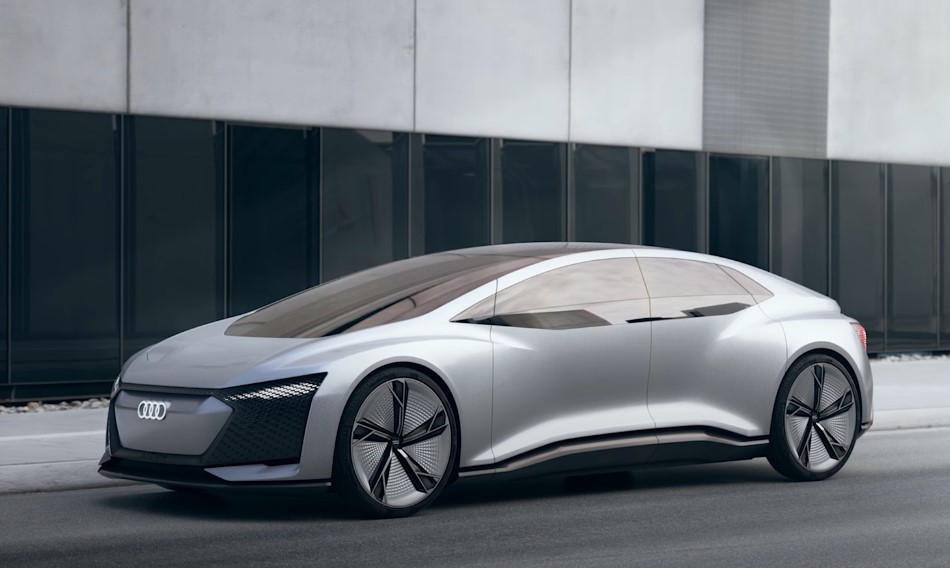
The Aicon’s exterior is both futuristic and elegant. Measuring 5,444 mm in length, 2,100 mm in width, and 1,506 mm in height, it commands a strong presence on the road.
The absence of traditional headlights and taillights is notable; instead, the Aicon features fully digital display surfaces composed of hundreds of triangular pixel segments. These can adapt to driving situations and even interact with pedestrians, enhancing both safety and visual appeal.
Key Specifications
Underneath its sleek exterior, the Aicon is powered by four electric motors, one for each wheel, delivering a combined output of 260 kW (approximately 350 horsepower) and 550 Nm (405 lb-ft) of torque.
This setup enables a 0-60 mph acceleration in 4.5 seconds. The vehicle boasts a range of 700 to 800 kilometers (435 to 497 miles) on a single charge, with an 80% recharge achievable in less than 30 minutes.
| Specification | Details |
| Power Output | 260 kW (350 hp) |
| Torque | 550 Nm (405 lb-ft) |
| 0-60 mph | 4.5 seconds |
| Range | 700-800 km (435-497 miles) |
| Charging Time | 80% in less than 30 minutes |
Advanced Technology
The Aicon is designed for Level 5 autonomous driving, eliminating the need for a steering wheel or pedals. Its interior resembles a luxurious lounge, featuring spacious seating and advanced communication systems.
The vehicle utilizes a combination of laser and radar sensors to navigate and detect obstacles, even in complete darkness. Additionally, the Aicon employs projector modules to communicate warnings and information to pedestrians, enhancing safety and interaction.
15. Piëch Mark Zero
The Piech Mark Zero’s design pays homage to the golden era of grand tourers, featuring a long bonnet and a sleek fastback roofline. Its harmonious round front grille draws inspiration from 1960s sports cars, while the elongated bonnet emphasizes its sporty character.
The elegant fastback roofline smoothly transitions to the rear, creating a cohesive and aerodynamic silhouette.
Key Specifications
| Specification | Details |
| Power Output | 603 hp (450 kW) |
| Torque | 820 Nm (605 lb-ft) |
| 0-100 km/h | ~3.0 seconds |
| Top Speed | 250 km/h (155 mph) |
| Battery Capacity | 70 kWh |
| Range | Over 500 km (310 miles) WLTP |
| Charging Time | 80% in 4 minutes 40 seconds |
Advanced Technology
The Mark Zero incorporates innovative technologies that enhance its performance and user experience:
- Rapid Charging: Thanks to a unique battery cell design, the car can charge up to 80% in just 4 minutes and 40 seconds, offering a range of over 500 km.
- Air-Cooled Battery System: The innovative battery design allows for effective air cooling, eliminating the need for liquid cooling systems and reducing vehicle weight.
- Flexible Vehicle Architecture: The platform is designed to accommodate various powertrains, including electric, hybrid, and traditional internal combustion engines, allowing for future adaptability.
Interior and Comfort
Inside, the Mark Zero offers a driver-focused environment with high-quality materials and a minimalist design.
The low seating position, typical of a sports car, combined with precise handling, provides an engaging driving experience.
14. Lightyear One and Lightyear 0
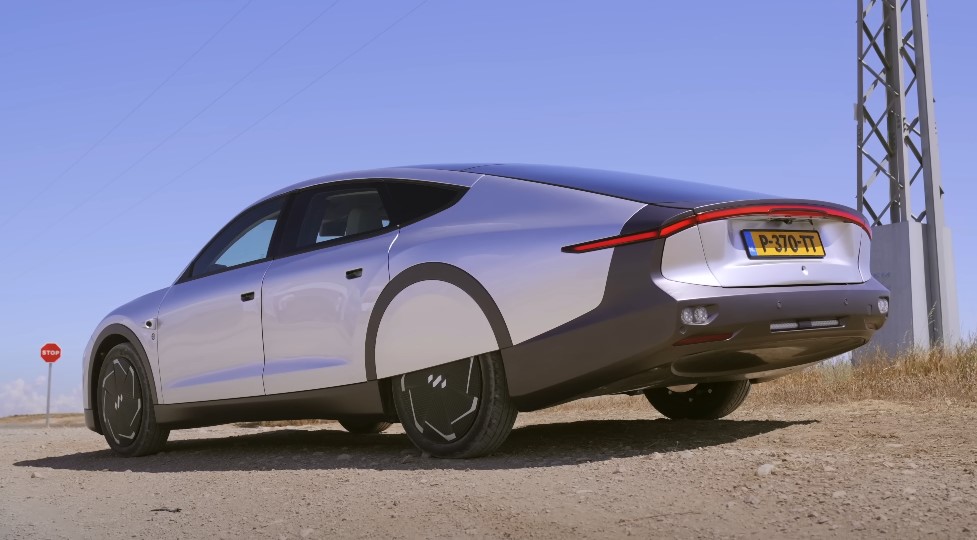
The Lightyear 0 incorporates 5 square meters of solar cells across its bonnet, roof, and boot, allowing it to harness solar energy efficiently.
This design not only enhances their futuristic appearance but also contributes to their energy efficiency.
Key Specifications
| Specification | Lightyear One | Lightyear 0 |
| Power Output | 130 kW (174 hp) | 130 kW (174 hp) |
| Torque | 1,720 Nm (1,269 lb-ft) | 1,720 Nm (1,269 lb-ft) |
| 0-100 km/h | 10 seconds | 10 seconds |
| Top Speed | 160 km/h (99 mph) | 160 km/h (99 mph) |
| Battery Capacity | 60 kWh | 60 kWh |
| Range (WLTP) | 725 km (451 miles) | 625 km (388 miles) |
| Solar Range Addition | Up to 60 km/day | Up to 70 km/day |
Advanced Technology
Both vehicles are equipped with cutting-edge technologies that set them apart:
- Solar Integration: The extensive solar panels enable the cars to charge themselves, reducing dependency on charging infrastructure and providing greater energy independence.
- Aerodynamic Efficiency: The Lightyear 0 boasts a record-low drag coefficient of Cd = 0.175, enhancing its energy efficiency and contributing to its impressive range.
- In-Wheel Motors: Both models utilize four independently controlled in-wheel motors, providing all-wheel drive capabilities and precise torque vectoring for improved handling and performance.
Interior and Comfort
Inside, the Lightyear One and Lightyear 0 offer minimalist yet comfortable cabins, emphasizing sustainability through the use of eco-friendly materials.
The spacious interiors and advanced infotainment systems provide a modern driving experience, aligning with their futuristic exteriors.
13. Mercedes-Benz Vision AVTR

Inspired by the film “Avatar,” the Vision AVTR features a flowing, organic design that seamlessly blends the interior and exterior. Its “One Bow” design philosophy creates a sleek, unified silhouette.
The vehicle’s exterior is adorned with 33 multi-directionally movable surface elements, known as “bionic flaps,” which can communicate with the driver and surroundings, enhancing its otherworldly appearance.
Key Specifications
| Specification | Details |
| Battery Technology | Organic, graphene-based battery |
| Charging Time | Full charge in less than 15 minutes |
| Range | Approximately 700 km (435 miles) |
| Drive System | Four high-performance electric motors, one at each wheel |
| Maneuverability | Capable of moving sideways by approximately 30 degrees (“crab movement”) |
Advanced Technology
The Vision AVTR incorporates several groundbreaking technologies:
- Biometric Connection: The vehicle establishes a biometric connection with the driver by recognizing their breathing patterns, creating a personalized and intuitive interaction.
- Brain-Computer Interface (BCI): This feature allows the driver to control various functions through thought, showcasing a new dimension of human-vehicle interaction.
- Sustainable Materials: The interior utilizes vegan DINAMICA® leather and fast-growing Karuun® (rattan) wood, highlighting a commitment to eco-friendly design.
12. Tesla Cybertruck

The Cybertruck’s exterior is crafted from ultra-hard 30X cold-rolled stainless steel, providing both durability and a distinctive appearance. Its angular, geometric design sets it apart from traditional pickup trucks, giving it a sci-fi allure. The absence of traditional door handles, replaced by flush buttons, adds to its sleek profile.
Key Specifications
| Specification | Cyberbeast (Tri-Motor AWD) | Dual-Motor AWD | Rear-Wheel Drive |
| Power Output | 845 hp | 600 hp | 400 hp |
| 0-60 mph | 2.6 seconds | 4.1 seconds | 6.5 seconds |
| Range (EPA est.) | 320 miles | 340 miles | 250 miles |
| Towing Capacity | 11,000 lbs | 10,000 lbs | 7,500 lbs |
| Payload Capacity | 3,500 lbs | 3,500 lbs | 3,500 lbs |
Advanced Technology
The Cybertruck is equipped with several innovative features:
- Adaptive Air Suspension: Adjusts the ride height for improved off-road capability and comfort.
- Rear-Wheel Steering: Enhances maneuverability, allowing the vehicle to move sideways, a feature Tesla refers to as “crab mode.”
- 48-Volt Electrical System: Reduces weight and increases efficiency compared to traditional 12-volt systems.
- Tesla Armor Glass: Ultra-strong glass designed to absorb and redirect impact forces for enhanced durability.
Interior and Comfort
Inside, the Tesla Cybertruck offers a minimalist design with seating for up to six adults. The dashboard features an 18.5-inch central touchscreen, providing access to vehicle controls and infotainment.
A rear 9.4-inch touchscreen offers additional functionality for passengers. The expansive glass roof enhances the sense of space and provides panoramic views.
11. Toyota FCV Plus
The FCV Plus features a compact, one-box design with a bubble-like glass canopy, providing expansive outward visibility.
Its exterior showcases a blue-tinted glasshouse dominating the upper section, while the lower third is covered in white bodywork, creating a striking contrast. The rear wheels are uniquely covered, enhancing its futuristic appearance.
Key Specifications
| Specification | Details |
| Length | 3,800 mm (149.6 inches) |
| Width | 1,750 mm (68.9 inches) |
| Height | 1,540 mm (60.6 inches) |
| Wheelbase | 3,000 mm (118.1 inches) |
The vehicle utilizes a hydrogen fuel cell stack located between the front wheels and a hydrogen storage tank positioned behind the rear seats.
This configuration, along with in-wheel motors at all four corners, allows for a spacious interior despite its compact exterior dimensions.
Advanced Technology
The FCV Plus incorporates several innovative technologies:
- Hydrogen Power Generation: Beyond using its onboard hydrogen, the vehicle can generate electricity from hydrogen stored externally, effectively transforming it into a mobile power plant capable of supplying electricity to homes or local grids.
- In-Wheel Motors: Each wheel is equipped with an independent motor, optimizing interior space and providing precise control.
- Energy Sharing: When parked, the FCV Plus can wirelessly charge other vehicles or contribute power to infrastructure, promoting a shared energy economy.
Interior and Comfort
Inside, the FCV Plus offers a minimalist cabin with seating for four. The absence of a traditional dashboard, replaced by a head-up display, and the use of advanced 3D processing techniques for the trim and seats contribute to a light and highly rigid skeletal structure.
10. Volkswagen XL1

Every curve and contour of the XL1 serves a purpose. Its low-slung body and teardrop shape minimize air resistance, allowing it to glide effortlessly.
The rear wheels are enclosed to reduce turbulence, and traditional side mirrors are replaced with cameras, enhancing both aerodynamics and aesthetics. Butterfly doors not only add to its futuristic appeal but also improve access to its cozy two-seat cabin.
Powertrain and Performance
Underneath its avant-garde exterior, the XL1 houses a plug-in hybrid system that combines a compact 0.8-liter two-cylinder TDI diesel engine with an electric motor.
This pairing delivers a modest 69 horsepower, but given the car’s lightweight construction—tipping the scales at just 795 kg—it achieves impressive performance. The Volkswagen XL1 can accelerate from 0 to 100 km/h in 12.7 seconds and reaches a top speed of 160 km/h.
Unmatched Efficiency
The XL1’s primary mission is efficiency. It boasts a fuel consumption rate of just 0.9 liters per 100 km, translating to an astonishing 261 miles per gallon.
Its 5.5 kWh lithium-ion battery provides an all-electric range of up to 50 kilometers, making short trips entirely emission-free.
Key Specifications
| Feature | Specification |
| Engine | 0.8L 2-cylinder TDI diesel |
| Electric Motor | 20 kW (27 PS) |
| Combined Power | 69 HP |
| Transmission | 7-speed dual-clutch automatic (DSG) |
| 0-100 km/h | 12.7 seconds |
| Top Speed | 160 km/h |
| Fuel Consumption | 0.9 L/100 km |
| CO₂ Emissions | 21 g/km |
| Electric Range | Up to 50 km |
| Curb Weight | 795 kg |
Limited Production
Volkswagen produced only 250 units of the XL1, making it a rare gem in the automotive world.
Its combination of groundbreaking design and technology has cemented its status as a collector’s item and a testament to what the future of cars might hold.
9. 2084 Chrysler Hover Vehicle
In “Total Recall,” set in 2084, Chrysler and Dodge hover cars navigate high-speed highways suspended hundreds of feet above the ground. These vehicles boast swappable steering columns and advanced stabilization systems, painting a picture of a high-tech future.
Bringing Fiction to Reality
The hover cars used in the film were meticulously crafted props. The hero car, driven by Colin Farrell’s character, Douglas Quaid, was one of several built for the movie.
Mounted on a gimble car operated by stunt drivers, the hover car could lean and rotate 360 degrees, creating the illusion of hovering.
Key Specifications
| Feature | Description |
| Design | Sleek, aerodynamic body with enclosed wheels and futuristic lighting elements |
| Propulsion | Fictional hover technology depicted in the film |
| Interior | Luxurious auto-mold seats wrapped in Nappa leather |
| Stabilization System | Class-leading photo-gyro stabilization for steady hovering |
| On-Screen Functionality | Mounted on a hydraulic system allowing dynamic movement during filming |
A Cinematic Icon
The 2084 Chrysler Hover Vehicle stands as a testament to innovative design and the enduring allure of futuristic transportation.
While it remains a product of cinematic imagination, it continues to inspire dreams of what the future might hold.
8. Extra-Terrestrial Vehicle (ETV)
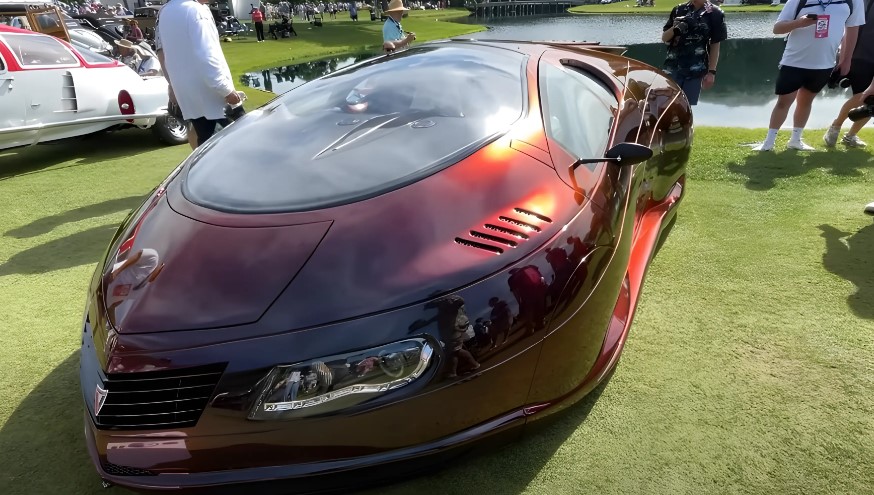
Crafted by Mike Vetter, founder of The Car Factory in Florida, the ETV was born from a desire to create something truly unique.
Vetter, who began his career building Ferrari and Lamborghini replicas, decided to design his own vehicle after facing legal challenges from the Italian automakers. The result? A car that looks like it belongs on another planet.
Futuristic Design
The ETV’s body is made primarily of fiberglass, featuring a teardrop shape that enhances its aerodynamic efficiency.
Its expansive windshield measures 4.5 feet wide by 5 feet long, providing an unobstructed view of the road ahead. Gullwing doors add to its futuristic appeal, making every entrance and exit feel like a scene from a sci-fi film.
Versatile Platforms
Underneath its distinctive exterior, the ETV can be built on various donor car platforms. Common choices include the Chevrolet Aveo and Cobalt SS, but some have been based on the Toyota Echo or even a Porsche Boxster.
This flexibility allows for a range of performance options, tailored to the owner’s preferences.
Key Specifications
| Feature | Details |
| Designer | Mike Vetter, founder of The Car Factory in Florida |
| Body Material | Primarily fiberglass with a large windshield measuring 4.5 feet wide by 5 feet long |
| Doors | Remote-operated gullwing doors |
| Seating Capacity | Front bucket seats with additional rear seating suitable for children |
| Rearview System | Cameras replacing traditional mirrors, displaying views on interior monitors |
| Donor Platforms | Commonly built on Chevrolet Aveo or Cobalt SS; also used Toyota Echo and Porsche Boxster |
| Engine Options | Varies with donor car; examples include 1.6L in Aveo, 2.2L Ecotec in Cobalt SS |
| Transmission | Typically automatic, depending on donor vehicle |
| Fuel Efficiency | Over 40 mpg, attributed to aerodynamic design |
| Production Volume | Extremely limited; only a handful produced, each custom-built |
Limited Production
The ETV is a rare find, with only a handful ever produced. Each vehicle is custom-built, reflecting the owner’s specifications and Vetter’s visionary design.
This exclusivity, combined with its striking appearance, makes the ETV a sought-after collector’s item.
7. Chevrolet FNR
The Chevrolet FNR (Find New Roads) concept car, unveiled at the 2015 Shanghai Auto Show, embodies a vision of futuristic automotive design and technology.
Its sleek, capsule-like body and innovative features make it appear more like a spacecraft than a traditional vehicle.
Futuristic Design Elements
- Dragonfly Dual Swing Doors: These unique doors open upwards, adding a dramatic flair reminiscent of sci-fi spacecraft.
- Crystal Laser Headlights and Taillights: Advanced lighting technology enhances the vehicle’s modern aesthetic.
- Magnetic Hubless Wheel Electric Motors: These wheels contribute to the car’s streamlined appearance and futuristic appeal.
Cutting-Edge Technology
- Autonomous Driving Capabilities: Equipped with sensors and roof-mounted radar, the FNR can map its environment for driverless operation.
- Iris Recognition Start: Instead of a traditional key, the vehicle uses iris scanning for ignition, adding a personalized security feature.
- Gesture Control: Allows the driver to switch between autonomous and manual driving modes seamlessly.
Interior Innovation
- Swiveling Front Seats: In self-driving mode, the front seats can rotate 180 degrees to face the rear seats, creating a lounge-like atmosphere for passengers.
- Chevy Intelligent Assistant: Acts as a personal assistant, mapping out optimal routes to the driver’s preferred destinations.
Key Specifications
| Feature | Description |
| Powertrain | Magnetic hubless wheel electric motors |
| Charging System | Wireless auto-charge |
| Lighting | Crystal laser headlights and taillights |
| Doors | Dragonfly dual swing doors |
| Autonomous Features | Sensors and roof-mounted radar for driverless operation |
| Interior Seating | Front seats swivel 180 degrees in self-driving mode |
| User Interface | Iris recognition start and gesture control for mode switching |
6. Phantom Corsair
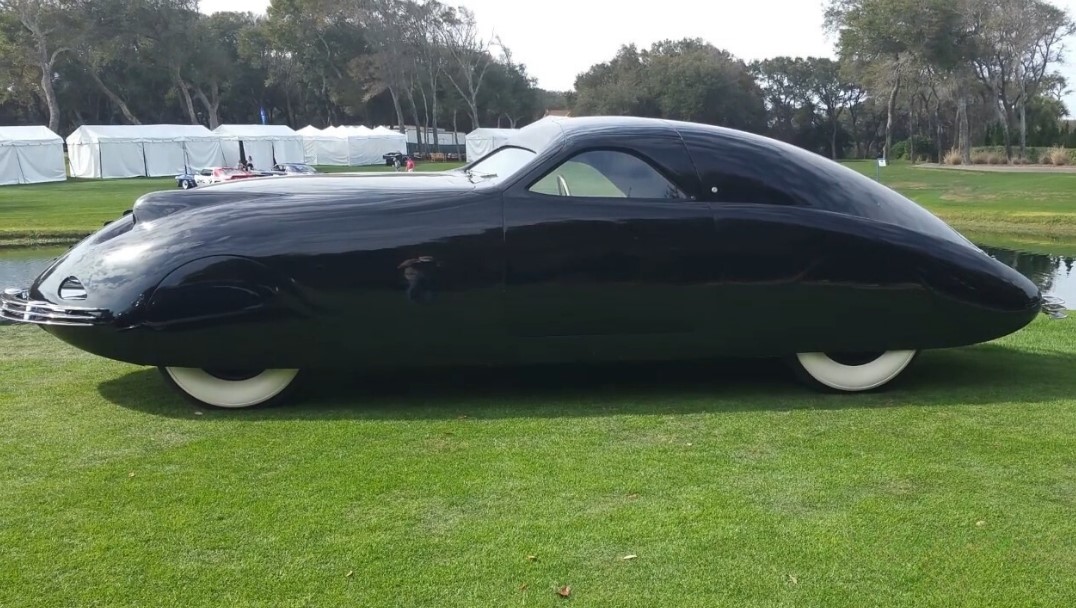
Designed by Rust Heinz, heir to the H.J. Heinz fortune, in collaboration with Maurice Schwartz of the Bohman & Schwartz coachbuilding company, the Phantom Corsair was intended to be America’s first supercar.
Heinz envisioned a vehicle that combined luxury, performance, and cutting-edge technology, resulting in a car that was truly ahead of its time.
Futuristic Design Elements
- Aerodynamic Body: The Corsair’s steel-and-aluminum body measured just 57 inches in height, featuring fully skirted wheels and flush fenders, eliminating the need for running boards.
- Electric Push-Button Doors: Doors operated electrically via push-buttons located on the exterior and the instrument panel, a novel feature in the 1930s.
- Advanced Lighting: Equipped with covered driving lights and fog lamps, enhancing visibility and adding to its sleek appearance.
Innovative Interior
- Seating Configuration: Designed to accommodate six passengers, with four seats in the front and two in the rear, utilizing the vehicle’s width efficiently.
- Safety Features: Included interior crash padding and hydraulic impact bumpers, emphasizing passenger safety.
- Climate Control: Featured an early version of a climate control system, providing comfort regardless of weather conditions.
Key Specifications
| Feature | Specification |
| Engine | 4.7L Lycoming V8 |
| Horsepower | 190 bhp at 4,200 rpm |
| Torque | 272 lb·ft at 3,000 rpm |
| Transmission | 4-speed automatic |
| Top Speed | Approximately 115 mph |
| Dimensions | 237″ L x 76.5″ W x 57″ H |
| Weight | 4,600 lbs |
| Wheelbase | 125 inches |
Legacy
Despite its groundbreaking design, the Phantom Corsair never entered mass production. The untimely death of Rust Heinz in 1939 halted further development.
The sole prototype now resides in the National Automobile Museum in Reno, Nevada, standing as a testament to visionary automotive design.
5. Eliica
The #Eliica and 8 wheeled #ElectricVehicle from #Keio university in #Japan can reach 230mph pic.twitter.com/dZyuRlZgqJ
— Quirky Rides (@QuirkyRides) September 12, 2023
The Eliica, short for Electric Lithium-Ion Car, is an innovative electric vehicle that truly embodies the concept of a car resembling a spaceship.
Developed in 2004 by Professor Hiroshi Shimizu and his team at Keio University in Tokyo, the Eliica stands out with its unique design and impressive performance capabilities.
A Glimpse into the Future
The Eliica’s most striking feature is its eight-wheel configuration, each housing a 60 kW in-wheel electric motor. This setup not only provides a combined output of approximately 640 horsepower but also contributes to its futuristic appearance.
The vehicle’s sleek, elongated body measures about 5.1 meters (17 feet) in length, enhancing its spaceship-like aesthetic.
Key Specifications
| Feature | Specification |
| Top Speed | Approximately 370 km/h (230 mph) |
| Acceleration | 0 to 100 km/h (62 mph) in about 4 seconds |
| Range | Between 200 km (120 miles) and 320 km (200 miles), depending on the version |
| Battery | Lithium-ion battery pack |
| Motors | Eight 60 kW in-wheel electric motors |
| Seating Capacity | Four passengers |
Innovative Features
- In-Wheel Motors: Each of the eight wheels contains its own electric motor, allowing for precise control and efficient power distribution.
- Advanced Battery Technology: The lithium-ion battery pack provides a substantial range, making the Eliica a practical option for longer journeys.
- Regenerative Braking: This system recovers energy during braking, enhancing overall efficiency.
A Visionary Project
Professor Shimizu’s goal with the Eliica was to demonstrate the potential of electric vehicles, aiming to surpass the top speeds of traditional gasoline-powered cars.
The project also explored the feasibility of producing a limited run of 200 units, highlighting a commitment to advancing electric vehicle technology.
4. Maserati Boomerang

The Maserati Boomerang, unveiled in the early 1970s, epitomizes the era’s fascination with futuristic, spaceship-like automotive design.
Crafted by the renowned designer Giorgetto Giugiaro of Italdesign, the Boomerang’s sharp angles and wedge-shaped profile make it a standout in automotive history.
Striking Design Features
- Wedge Shape: The Boomerang’s body features a pronounced wedge design, with a windscreen angled at a mere 13 degrees, creating a sleek, aerodynamic silhouette.
- Innovative Interior: Inside, the Boomerang boasts a unique dashboard where the steering wheel and gauge cluster form a single console. The steering wheel rotates around stationary gauges, offering a futuristic driving experience.
- Extensive Glasswork: The vehicle’s expansive glass surfaces, including angular side windows and a remarkably flat windscreen, enhance its spaceship-like appearance.
Key Specifications
| Feature | Specification |
| Engine | 4.7L DOHC V8 |
| Power | 310 hp at 6,000 rpm |
| Torque | 460 Nm at 4,200 rpm |
| Transmission | 5-speed manual |
| Top Speed | Approximately 300 km/h (186 mph) |
| Dimensions | L: 4,342 mm, W: 1,860 mm, H: 1,070 mm |
| Weight | 1,400 kg |
Legacy and Influence
Debuting as a non-functional model at the 1971 Turin Motor Show, the Boomerang was transformed into a fully operational vehicle by the 1972 Geneva Motor Show.
Its daring design influenced numerous production models, including the Lotus Esprit and DeLorean DMC-12, cementing its status as a pivotal concept in automotive design.
3. Aptera 2e
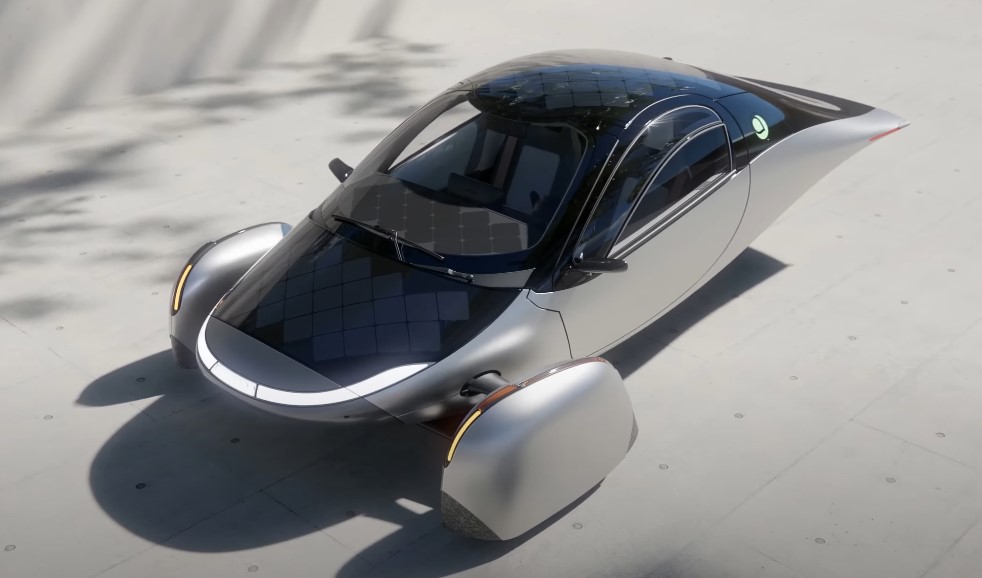
The Aptera 2e stands out as a futuristic vehicle that resembles a spaceship gliding on the road. Its unique design and innovative features make it a notable example of forward-thinking automotive engineering.
Sleek, Aerodynamic Design
The Aptera 2e’s teardrop shape and three-wheel configuration contribute to its ultra-low drag coefficient of 0.15, enhancing both efficiency and its spaceship-like appearance.
Key Specifications
| Feature | Specification |
| Dimensions | 53″ H x 91″ W x 173″ L |
| Wheelbase | 111 inches |
| Curb Weight | 1,500 lbs |
| Drag Coefficient | 0.15 |
| Battery Pack | 10-13 kWh Lithium Iron Phosphate |
| Range | Up to 100 miles per charge |
| Charging Time | 8 hours on 110V 15A |
Notable Features
- Three-Wheel Configuration: The two front wheels and a single rear wheel design reduce rolling resistance and weight, contributing to its efficiency.
- Lightweight Construction: Utilizing composite materials, the vehicle maintains a low curb weight, enhancing performance and range.
- Advanced Safety Measures: Designed with a safety cell and crumple zones, the Aptera 2e aims to protect occupants effectively.
2. Mercedes-Benz Biome
@verentsoff #обзор#авто#будущее ♬ оригинальный звук – Роман
The Mercedes-Benz BIOME concept car, unveiled at the 2010 Los Angeles Auto Show, presents a visionary approach to automotive design, seamlessly integrating with nature.
Its organic aesthetics and groundbreaking features make it a standout example of a vehicle that resembles a spaceship.
A Car Grown from Nature
- BioFibre Construction: The BIOME is crafted from an ultralight material called BioFibre, grown from proprietary DNA in a specialized nursery. This material is lighter than metal or plastic yet more robust than steel.
- Organic Energy Storage: The vehicle stores energy in a liquid chemical bond known as BioNectar4534, which is collected from the sun and stored within the BioFibre material of the chassis, interior, and wheels.
Symbiotic Design Elements
- Seed-Derived Growth: The BIOME is envisioned to grow organically from two seeds—the interior from the DNA in the front Mercedes star and the exterior from the rear star. This process allows for customization to specific customer requirements.
- Eco-Friendly Lifecycle: Throughout its lifespan, the BIOME emits pure oxygen, contributing positively to air quality. At the end of its service life, it can be fully composted or repurposed as building material, ensuring a harmonious return to the ecosystem.
Key Specifications
| Feature | Description |
| Material | BioFibre—ultralight and stronger than steel |
| Energy Source | BioNectar4534—solar energy stored in liquid chemical bonds |
| Weight | Approximately 875.5 lbs (394 kg) |
| Emission | Pure oxygen during operation |
| Lifecycle End | Fully compostable or usable as building material |
1. Ferrari 512S Modulo

The Ferrari 512S Modulo, unveiled at the 1970 Geneva Motor Show, stands as a testament to avant-garde automotive design, embodying a futuristic aesthetic that closely resembles a spaceship.
Designed by Paolo Martin of Pininfarina, the Modulo’s radical form and innovative features continue to captivate car enthusiasts and designers alike.
Striking Design Features
- Wedge-Shaped Body: The Modulo showcases an extremely low, wedge-shaped profile, measuring just 935 mm (36.8 inches) in height, emphasizing aerodynamic efficiency and a futuristic look.
- Canopy-Style Glass Roof: Entry to the cabin is facilitated by a canopy-style glass roof that slides forward, a design more akin to aircraft than traditional automobiles.
- Partially Covered Wheels: All four wheels are partially enclosed, contributing to the vehicle’s sleek lines and reducing aerodynamic drag.
- Distinctive Engine Cover: The rear engine cover features 24 holes, offering a glimpse of the powerful V12 engine beneath, adding to its unique character.
Key Specifications
| Feature | Specification |
| Engine | 5.0L V12 |
| Power Output | 550 hp at 8,500 rpm |
| Top Speed | Approximately 220 mph (354 km/h) |
| 0-60 mph | Around 3.0 seconds |
| Dimensions | L: 4,480 mm, W: 2,040 mm, H: 935 mm |
| Wheelbase | 2,405 mm |
Legacy and Impact
The Ferrari 512S Modulo earned 22 international design awards, highlighting its significance in automotive design history. Its daring aesthetics and innovative features have inspired numerous designers and continue to influence modern concept cars.
The Modulo remains a symbol of Ferrari’s commitment to pushing the boundaries of automotive design, blending high performance with a visionary approach that still feels ahead of its time.
Why Spaceship Cars Capture Our Imagination
Cars that look like spaceships aren’t just about striking designs—they’re statements of what’s possible. From pioneering sustainable materials to integrating advanced autonomous technologies, these vehicles inspire dreams of a more innovative, eco-conscious future.
Whether you’re an automotive enthusiast or just someone who appreciates daring design, these machines offer a glimpse of tomorrow today.
Related Posts:
- Can Electric Trucks Handle the Heavy Lifting? A Look…
- What to Look for in a Pre-Owned EV? Battery Life,…
- Why Does My Car Smell Like Gas? Common Causes and Solutions
- Are Electric Vehicles Safer? Comparing EVs and…
- Crash Safety Showdown: Electric Vehicles vs.…
- 15 Best Electric Cars Under $50,000 in 2025 -…







